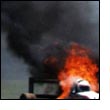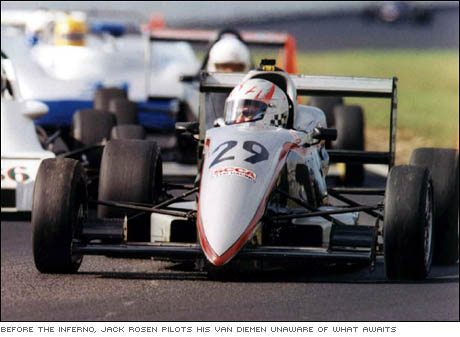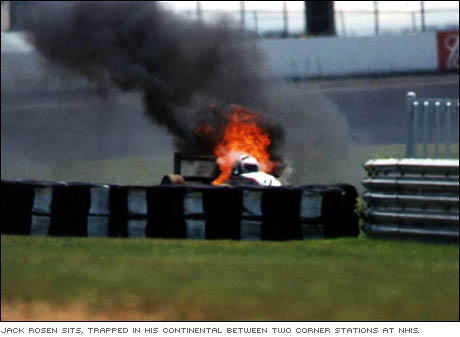 
|
Feature Articles |
|
Do you have something that can help out your fellow racers? Do you have a secret urge to be a writer or teacher?
If you or someone you know would like to contribute an article for the Features on F2000.com, please do drop us a note and let us know how you would like to contribute. We are always looking for more bricks for the building. |
|
|
|
 |
| . |

Originally published in December/January 2002 Pit Talk, the official publication of the New England Region SCCA
 With a name like Rosen, I guess the last place I should have been at July 14th and 15th was the "Annual Pig Roast" at New Hampshire International Speedway. It almost was renamed the "Rosen Roast." With a name like Rosen, I guess the last place I should have been at July 14th and 15th was the "Annual Pig Roast" at New Hampshire International Speedway. It almost was renamed the "Rosen Roast."
Before I get into the hot details of this event, a little background. While new to SCCA this year, my racing started in Canada back when four wheel drifts through a corner were the norm, and we used the engine to supply most of the steering and braking power. The first car I had on a track was a slightly modified Morris Minor, followed by a three-year-old TR2, a Jaguar XK140 MC, then a XK150 SS, and a brand new Sprite to which I added disk brakes, wire wheels, and a Shorrock supercharger. The club I belonged to at the time was the British Empire Motor Club, and we were responsible for the creation of two tracks, the first being Harewood, built on a WWII airport in Ontario near the shores of Lake Erie, and Mosport, 50 miles east of Toronto. Racing in those days did not even require a roll bar, and seat belts were an option. Any thing that looked like a helmet would do, and wearing goggles made you look cool too. I don't remember seeing anyone driving in shorts, but it's possible it happened.
Besides racing cars, I have also raced bicycles, sailboats, ice boats, and do competition aerobatics in a monoplane I built that's capable of attaining 250 mph on the backside of some maneuvers.
As speed and competition were no strangers to me, and when I retired at an early age it seemed natural to get back into auto racing. This also afforded the opportunity for my wife Sandi, a schoolteacher with summers off, to be my crew chief and traveling companion. We built a replica Cobra, joined COM, (a driving school and time trial club in the New England Area) and started to compete with COM and two local autocross clubs. Even did a three-day open wheel driving school with Skip Barber at Sebring. Always loved watching open wheeled cars, so in late spring of 2001 we added a 1997 Van Diemen Formula Continental to Rosen Racing and proceeded to work on our SCCA driving license. And that ‘s why we were at the Pig Roast hoping to update our Novice License to a Regional status.
My first race Saturday was uneventful starting about in the middle of the group. Aside from being forced off the track before turn three on the first lap, and looping on turn six because of a sloppy downshift about lap ten, I was happy to have survived and ready to race the next day.

Got a little better start this time, got through the logjam at three, and was comfortable enough to notice upon reaching the front straight a hot smell in the cockpit similar to, but not quite like hot rubber. It seemed rather early in the race for tires to be that hot, so on the front straight the second time around I peeked down at the panel to check water temperature and was informed all was well as far as engine temperature was concerned. Entering the front straight the third time became a little more interesting. About the same time I noticed in my rear view mirrors the flames pouring out of every opening in the engine cowl, my son Ben (now a Speed Freakz) was informing me in a very excited way over the radio that I was on fire. I acknowledged that indeed he was correct and proceeded to what I thought was the best place on the track to pull off and get out of the way of traffic behind me. That was the grass area between turns two and three. Upon braking I noticed a longer brake pedal travel, and the front wheels lock up, so I knew the rear hydraulic lines had burned through.
At this point, let me state that everything that could have gone wrong, did. First, I stopped about midway between flagging stations. Second, the fire system would not activate. Third, I forgot to remove the steering wheel. Fourth, the belts (eight of them) all jammed and in that tight cockpit I couldn't untangle them and was stuck. Actually, when the major part of your seat is the fuel cell, and that's where the flames are coming from, you tend to get a little excited.
At this point in the story and me sitting in the middle of the BBQ, let me stop here and say my heartfelt thanks to the workers who like those brave firemen in New York, literally risked their lives to save mine. I got whisked away so quickly in the ambulance, that I never got a chance to personally thank them as they we still putting out the fire. My apologies to John Ultring who I made to run so far carrying that heavy fire extinguisher because I didn't stop closer to his flag station. My thanks to Brian Miller, Doug White, Greg Shekita and Mary Anne Lyons. I know one of you helped to untangle the seat belts, but because of the flames reaching up my back, the smoke, and the stream of halon, I don't know who it was. I'm sure the same thought I had of the car acting like a bomb was in their minds as it was in mine. Thank you again for your bravery.
Eventually with four fire extinguishers aimed at the fire and me, and now with loosened belts, I was able to exit the car and the flames safely. The medical people determined it was in my best interest to visit the hospital in town due to the amount of smoke and halon I might have ingested. Fortunately, my lungs were clear, and many hours later headed back to the track to face the sad chore of loading up the remains, which when I last saw, was still smoking as they shut the ambulance door. Imagine to my great surprise and pleasure, and thanks to the efforts of GT1 driver Fred Myers, his crew chief Ed Hough, and others, the car and my canopy were packed in the trailer, tied down, and ready to travel. A great example of the SCCA Spirit.
When I got the car back to my shop the sad chore of repairing was started. Initially it was believed the fire started due to a leak in the fuel cell filler neck, which later proved to be incorrect upon removal and inspection of the tank. My next suspect was a crack found in the fuel tank overflow-vent hose, but this was overridden when Kent Jones of Precision Motor Werks started to overhaul the engine and found the top of the carburetor was loose, allowing fuel to pour out of the fuel bowl. This made more sense due to the amount of flames that were present. With the overhead air ducts feeding the carb, I had never had these ducts off in the short time I had owned the car. Had I, I might have noticed the loose screws.

In summary, I learned a lot from this experience, and I believe others could benefit also. Fire is, I believe the least problem we think we might encounter in an auto racing accident, but I believe it's the most horrific circumstance we might find ourselves in due to after effects of being burned. And yet, it is almost the easiest to protect against. Use all the Nomex you can, and not the minimum required. I was wearing a triple layer suit with full turtleneck underwear. Nomex socks, gloves, balaclava, and boots. In this case, my neck collar stopped the flames from getting in under my helmet. I could tell this by the way the label on the collar was singed, and the clear coat on my newly painted helmet was yellowed.
Driver recommendations:
1. While touring the track, observe where all the flagging stations are, and mentally find and remember a spot where you can pull off to get quick assistance.
2. Periodically check your fire system. The SCCA scrutineer who checked the car after the fire while I was still at the hospital found the inner cable frozen to the outer, although he was able to remove it with some effort after releasing the anchor pin. I remember as I was slowing down I tried pulling the handle but it would not move. When the car came to a stop, I tried to pull the handle with both hands, which is very awkward in the tight confines of a Formula Continental especially when you weigh 195 pounds. I thought I heard some hissing noises at that time, similar to a fire being squelched, and photos did show some white smoke, but the system would not continue to operate (if it was at all), and at that time I had only thoughts of exiting the vehicle.
Upon reassembly of the inner cable after cleaning and lubricating it well, it moved quite freely in and out, EXCEPT when slightly rotating it clockwise or counterclockwise as you tried to pull it. There is a centering pin and slot assembly that keeps the handle aligned when the outer cable is locked down to the cars attach point, and this seems to jam if slightly rotated. I suspect this along with some corrosion might have contributed to my inability to pull the handle out fully to enable the locking mechanism on the extinguisher to catch and hold the handle open.
My suggestion is to routinely (at least at the beginning of the season) release the anchor pin, sit in the car in full driving dress, and try to activate the system. Make whatever changes you have to if not satisfied.
3. Every time you exit the vehicle, practice an emergency exit. Not to say it has to be as quick as possible, but follow the same procedure every time so it becomes routine and you don't have to think about what to do. The reason I jammed the belts was because after I released the cam lock, I tried to stand up without taking off the steering wheel. My procedure now is to remove the wheel first, release the cam lock, then pull each shoulder strap up and clear, to release the other two belts that each shoulder strap is holding to the lock. This I do ever time I exit the car, in that order.
4. Inspect and improve any possible hazards in you engine compartment. Bring it up to aircraft standards. In my case I've replaced two of the six carburetor screws with screws that can be safety wired together, and the other four that are recessed, have new lock washers. Hoses should not be subject to chaffing, and cover all exposed fuel hoses in the engine compartment with properly installed fire sleeve.
5. Despite common practice in Formula cars that have absolutely no fuse protection because of vibration, install some sort of in-line fuse to your main run switch. Vibration will not loosen a properly installed in-line fuse, and they weigh nothing. The thought of having unprotected wires running through the car in case of an accident doesn't make much sense.
I'm happy to report that we were able to get the car ready for testing a few days before the "Cheap Date" event at New Hampshire. Testing went well, so we drove the event and completed our regional license. I hope that some of my hard earned lessons will be of some benefit to other SCCA members.
At a recent COM event, I hung up the sequential pictures on my trailer door that Roz Rosintoski took of the fire, and more than one driver who saw the enormity of the flames claimed they were going to rethink their driving attire.
Once again my thanks to all the help I received, the phone calls from well wishers, and the general SCCA spirit. I'm glad my family has joined the SCCA family.
Jack Rosen
Rosen Racing
All content is property of F2000.com and its authors. No material on this page may be reproduced or reused without the express permission of F2000.com and Tom Johnson. ©2002 F2000.com and FormulaContinental.com
|
|

